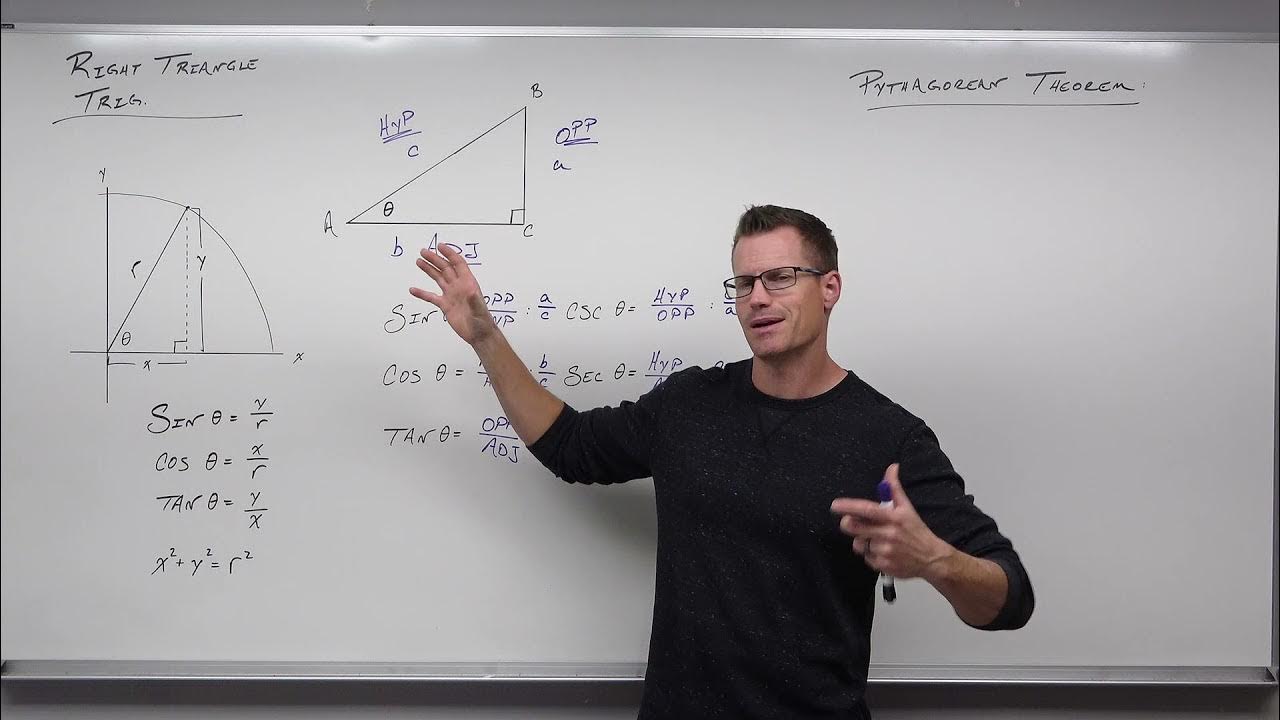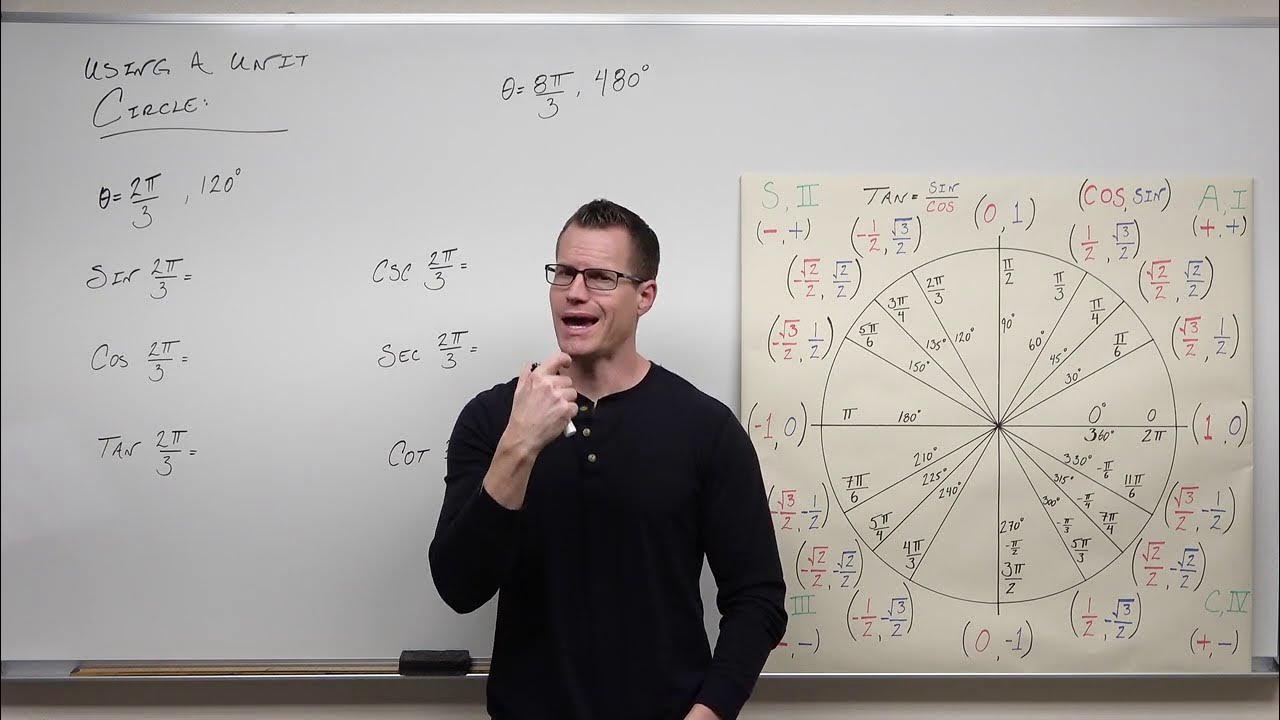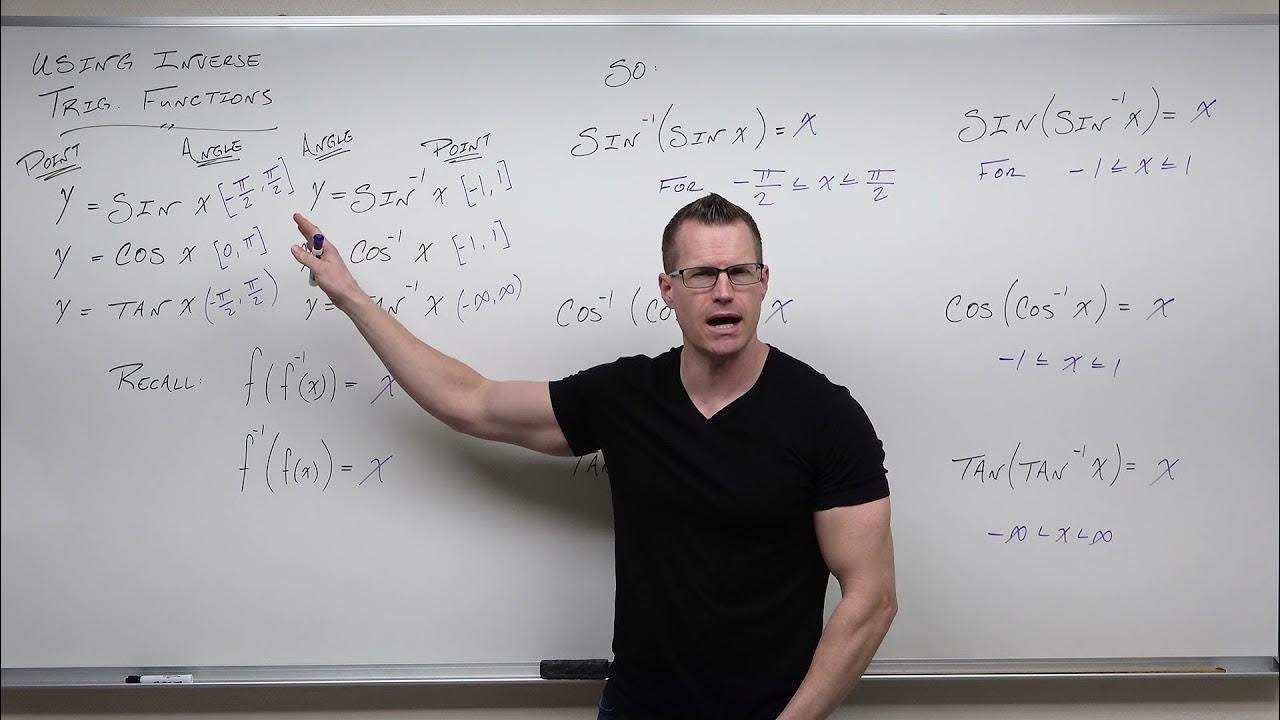Basic Properties of Trigonometric Functions (Precalculus - Trigonometry 8)
TLDRThe video script offers an in-depth exploration into the properties and relationships of trigonometric functions, focusing on sine, cosine, tangent, cosecant, secant, and cotangent. It delves into how these functions relate to the unit circle and their respective x and y coordinates. The concept of reciprocal trigonometric functions is introduced, highlighting their inverse relationships. The script also discusses the domain and range of these functions, explaining why certain angles are excluded from the domain due to undefined outputs, particularly when denominators are zero. The periodic nature of trigonometric functions is emphasized, with the period defined as the interval after which the outputs of the functions repeat. This understanding is crucial for graphing and applying trigonometric identities. The video script concludes with a method to simplify angles that exceed one period by using the concept of remainders upon division, a technique that is particularly useful for quickly determining equivalent angles within a unit circle.
Takeaways
- 📐 The basic properties of trigonometric functions (sine, cosine, tangent, cosecant, secant, and cotangent) are interconnected through identities and can be understood in relation to each other.
- 🔄 Trigonometric functions are periodic, with sine and cosine repeating every 2π, and tangent and cotangent repeating every π.
- 📉 The domain of the sine function includes all real numbers, as it corresponds to the y-coordinate on the unit circle, which ranges from -1 to 1.
- 📈 The range of the sine function is also between -1 and 1, which are the limits of the y-coordinate on the unit circle.
- 🚫 Cosecant has a restricted domain because it is the reciprocal of the sine function, and it is undefined where the sine function equals zero.
- 🔸 Cosine relates to the x-coordinate on the unit circle, and its domain is all real numbers, similar to sine.
- 🔹 The range of the cosine function is also between -1 and 1, corresponding to the x-coordinate on the unit circle.
- ↔️ Tangent is the ratio of the sine to the cosine functions and has a domain that excludes angles where the cosine function is zero, to avoid division by zero.
- 🚨 The range of the tangent function is all real numbers, as it represents the ratio of y to x on the unit circle, which can be very large or small but never undefined.
- 🤔 Understanding the signs of the trigonometric functions can help determine the quadrant of the angle on the unit circle.
- 🔁 The concept of period is essential for graphing trigonometric functions and allows for the simplification of angles that exceed one full revolution or half revolution for tangent and cotangent.
Q & A
What is the basic concept of trigonometric functions?
-Trigonometric functions relate an angle to a ratio of two sides in a right triangle or the coordinates of a point on the unit circle.
How is the sine function related to the unit circle?
-The sine of an angle is given by the y-coordinate of the corresponding point on the unit circle.
What is the domain of the sine function?
-The domain of the sine function is all real numbers because for any angle, the sine function will return a valid y-coordinate value between -1 and 1.
How does the cosine function differ from the sine function in terms of the unit circle?
-The cosine function is related to the x-coordinate of a point on the unit circle, whereas the sine function is related to the y-coordinate.
What is the range of the tangent function?
-The range of the tangent function is all real numbers because as the angle varies, the ratio of the y-coordinate to the x-coordinate can take on any value, even extending to infinity or negative infinity.
Why does the cosecant function have a limited domain?
-The cosecant function has a limited domain because it is the reciprocal of the sine function, and it is undefined where the sine function equals zero, which occurs at 0 and π radians (or 0 and 180 degrees).
What is the relationship between the tangent and cotangent functions?
-The tangent function is the ratio of the sine to the cosine function, and the cotangent is the reciprocal of the tangent, which means it is the ratio of the cosine to the sine function.
What is the significance of the period of a trigonometric function?
-The period of a trigonometric function is the interval on which the outputs of the function repeat. It helps in graphing and understanding the behavior of the function over time.
How can you determine the quadrant in which an angle lies using the signs of trigonometric functions?
-By knowing the signs of functions like sine, cosine, and tangent in each quadrant, one can determine the quadrant of an angle. For example, if sine is positive and cosine is negative, the angle is in the second quadrant.
What is the identity that relates tangent and sine and cosine functions?
-The identity that relates tangent to sine and cosine is: tangent of an angle equals the sine of the angle divided by the cosine of the angle.
How can you simplify angles that are more than one period for trigonometric functions?
-You can simplify angles greater than one period by subtracting the period (2π for sine, cosine, secant, and cosecant; π for tangent and cotangent) repeatedly until the angle falls within the standard interval (0 to 2π for sine, cosine, secant, and cosecant; 0 to π for tangent and cotangent).
Outlines
😀 Introduction to Trigonometric Functions and Identities
The video begins with an introduction to trigonometric functions, including sine, cosine, tangent, cosecant, secant, and cotangent. It emphasizes the interrelation of these functions and the concept of identities, which are mathematical relationships that allow for deeper understanding and extrapolation in trigonometry. The unit circle is introduced as a convenient tool for correlating angles with points on the circle, and thus with the trigonometric functions. Sine is related to the y-coordinate, and cosecant to its reciprocal, while cosine is associated with the x-coordinate, and secant with its reciprocal. Tangent and cotangent are defined in terms of ratios of these coordinates.
📐 Domain and Range of Sine and Cosine Functions
The second paragraph delves into the domain and range of the sine and cosine functions. The domain is the set of all possible input angles that yield a valid output, while the range is the set of all possible output values. For sine, the domain is all real numbers, as every angle results in a y-coordinate between -1 and 1, which is also the range. Similarly, cosine has a domain of all real numbers, with its range being the same interval on the x-axis. The importance of avoiding division by zero, which would result in an undefined value, is highlighted.
🚫 Understanding the Domain Limitations of Cosecant and Secant
The third paragraph discusses the limitations in the domain of the cosecant and secant functions. Since cosecant is the reciprocal of sine, it is undefined where sine equals zero, which occurs at every multiple of pi. This leads to a domain that excludes these specific angles. The range of cosecant is all real numbers except for zero because the reciprocal of zero is undefined. The secant function, being the reciprocal of cosine, faces the same issue at every multiple of pi, leading to the same domain restrictions.
🔢 Domain and Range of Tangent and Cotangent Functions
The fourth paragraph explores the domain and range of the tangent and cotangent functions. Tangent, being the ratio of y to x, is undefined where x equals zero, which is at pi/2 and 3pi/2 radians. This sets the domain of tangent to exclude these angles. The range of tangent is all real numbers because as x approaches zero, the ratio y/x can become infinitely large or small. Cotangent, the reciprocal of tangent, shares the same domain restrictions due to the same undefined nature at x equals zero.
🔁 Periodicity of Trigonometric Functions
The fifth paragraph explains the concept of periodicity in trigonometric functions. The period is the interval over which the outputs of the trigonometric functions repeat. For sine and cosine, the period is 2π, meaning their outputs repeat every 2π radians. For tangent, the period is π because it repeats every half rotation. The reciprocal functions, cosecant and secant, share the same period as their respective originals, sine and cosine, while cotangent has the same period as tangent.
➗ Simplifying Angles Using Periodicity
The sixth paragraph demonstrates how to simplify angles that exceed one period of a trigonometric function using the concept of periodicity. By subtracting multiples of the period from the angle until the result lies within the fundamental interval of the unit circle, one can easily determine the value of the trigonometric function. This method is applicable to all trigonometric functions and is particularly useful for quickly finding the equivalent angle within the unit circle.
🔢 A Quick Method for Simplifying Angles
The seventh paragraph introduces a quick method for simplifying angles that involve more than one period of a trigonometric function. This method involves multiplying the denominator of the angle by the period of the respective trigonometric function and then finding the remainder of the numerator when divided by this product. The remainder becomes the new numerator, and the denominator remains the same, resulting in an equivalent angle on the unit circle.
📉 Determining Quadrants Using Signs of Trigonometric Functions
The eighth paragraph discusses how to determine the quadrant of an angle based on the signs of the trigonometric functions. Since the signs of sine and cosecant are the same, as well as secant and cosine, and tangent and cotangent, one can deduce the quadrant by knowing the signs of these functions. For example, if the secant is negative and sine is positive, the angle must be in quadrant II. This understanding is crucial for applying trigonometric identities and solving problems involving angles.
🔄 Reciprocal Identities and Next Steps
The final paragraph teases the topic of reciprocal identities, which will be covered in the next video. It also provides a summary of the importance of understanding the interplay between the signs of trigonometric functions and their quadrants. The video concludes on a positive note, encouraging viewers to practice these concepts to solidify their understanding.
Mindmap
Keywords
💡Trigonometric Functions
💡Unit Circle
💡Reciprocal Trigonometric Functions
💡Domain and Range
💡Periodicity
💡Sine Function
💡Cosine Function
💡Tangent Function
💡Cosecant Function
💡Secant Function
💡Cotangent Function
Highlights
Introduction to the basic properties of trigonometric functions: sine, cosine, tangent, cosecant, secant, and cotangent.
Explaining how trigonometric functions relate to each other through identities.
Using the unit circle to understand the relationship between sine, cosine, and their respective reciprocals, cosecant and secant.
Defining tangent and cotangent in terms of ratios of sides in a right triangle and their reciprocal relationship.
Discussing the domain and range of trigonometric functions and how to determine them.
Illustrating the concept that all angles are defined for sine and cosine functions, leading to their domain of all real numbers.
Describing the range of sine and cosine functions as all real numbers between -1 and 1, inclusive.
Clarifying the difference between domain (input) and range (output) for trigonometric functions.
Explaining the graphical representation of sine and cosine functions and their periodic nature.
Identifying the period of the sine and cosine functions as 2π, which is a full rotation on the unit circle.
Discussing the domain restrictions of the tangent function, which excludes angles where the cosine is zero.
Describing the range of the tangent function, which includes all real numbers due to its ratio of sine to cosine.
Detailing the domain and range of the reciprocal trigonometric functions, such as cosecant and secant, and their relationship with zero values.
Providing a method to simplify angles that exceed the period of a trigonometric function using division and remainders.
Demonstrating how to use the periods of trigonometric functions to find equivalent angles within a standard interval.
Using the concept of periods to translate angles outside the normal interval into equivalent angles on the unit circle.
Highlighting the importance of understanding the signs of trigonometric functions to determine the quadrant of an angle.
Concluding with the significance of mastering the interplay between the signs of trigonometric functions and their quadrant locations.
Transcripts
Browse More Related Video

Calculus 1 Lecture 0.3: Review of Trigonometry and Graphing Trigonometric Functions

Introduction to Right Triangle Trigonometry (Precalculus - Trigonometry 30)

Trig Visualized: One Diagram to Rule them All (six trig functions in one diagram)

Trig 0.2 - Trig Functions Defined on the Unit Circle

How to Use the Unit Circle in Trigonometry (Precalculus - Trigonometry 7)

How to Use Inverse Trigonometric Functions (Precalculus - Trigonometry 18)
5.0 / 5 (0 votes)
Thanks for rating: